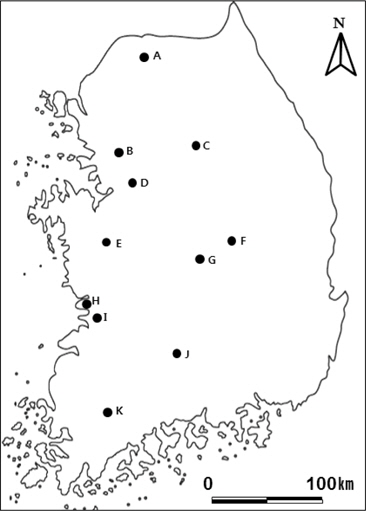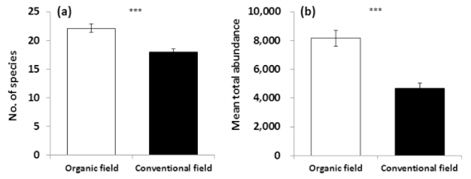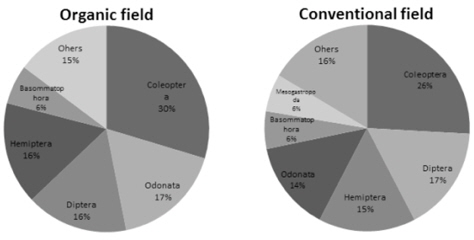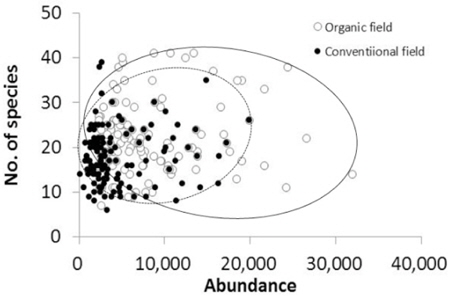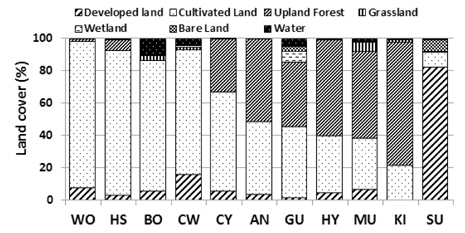



Today, environmentally friendly farming has become an important feature of agricultural policy. It promotes or sustains farming systems which protect and enhance the environment. This study was conducted to compare benthic invertebrate communities in an organic and a conventional paddy field in South Korea.
Benthic invertebrates were collected at 11 regions of a rice paddy from June to August, 2009, 2010 and 2011. These comparisons undertaken using a community assessment approaches such as the number of individuals and species and community composition. Generally, the larger number of individuals and species of benthic invertebrates was observed in an organic paddy than in a conventional paddy field. Organic paddy fields could supported the wider range of species and abundance in aquatic invertebrates comparing to conventional paddy fields. Carrying capacity to support larger numbers of invertebrates also tends to be higher in organic paddy than in conventional paddy field. Specially, organic farming regions surrounded by forests were high quality habitat for benthic invertebrates than other surrounded regions such as grassland.
We concluded that organic farming was more advantaged to benthic invertebrates than conventional farming. In order to improve biodiversity in rice paddy field, farming regimes without agricultural chemicals are recommended. The effect of organic management on biodiversity and abundance of benthic invertebrates could be maximized across highland farmland.
최근 사회의 발전과 더불어 소비자들의 요구가 다양화되고, 환경에 대한 관심이 증가하면서 환경 보전에 기여하는 농업으로의 전환에 대한 필요성이 커지게 되었다(Selfa
논은 식량자원인 벼를 재배하기 위한 중요한 공간이며 물이 공급된 논에 모를 심으면서 벼의 재배가 시작된다. 이러한 물의 공급은 벼의 생산성을 높임과 동시에 다양한 생물의 서식공간을 제공하게 된다(Elphick and Oring, 2003; Taft and Haig, 2005). 대부분의 논은 벼의 이앙기부터 출수기 전까지 물을 공급하기 때문에 제한된 기간이지만 지속적이고 주기적으로 습지를 형성한다. 논 생태계의 이러한 특성으로 인해 매년 조류, 양서류, 어류, 곤충류 등 다양한 생물상들이 출현한다(Paoletti, 1995). 특히, 저서무척추동물은 논 생태계 에서 저차소비자에 위치하기 때문에 먹이사슬에서 매우 중요한 역할을 차지하고 있다(Smeding and de Snoo, 2003). 일반적으로 저서무척추동물은 육상곤충과 같이 육상생활을 하던 곤충류가 2차적으로 다시 수중 생활을 하게 된 것으로 생활사(life history)가 변화된 환경에 알맞게 적응된 것들이 대부분이다(Huryn, 2009; Brand and Miserendino, 2012). 이들은 서식환경과 수질의 특성에 따라 독특한 분포를 보이기 때문에 수질오염을 평가하는 지표생물로도 많이 이용되고 있다(Guilpart
본 연구는 유기농업 논과 관행농업 논을 전국 단위에서 선정하여 두 재배법에 따른 저서무척추동물의 특성을 파악하고자 한다. 이를 통해 논 생태계의 다양성 보존과 복원을 위한 기초 자료를 제공하고자 한다.
본 연구는 2009년부터 2011년까지 3년에 걸쳐 전국 11개 지역(철원, 원주, 수원, 안성, 청양, 문경, 보은, 군산, 김제, 함양, 화순)을 대상으로 실시하였다(Fig. 1). 각 지역에서는 인접한 유기농법으로 재배하는 논과 관행농법으로 재배하는 논을 선정하였다. 각 지점별 조사는 이앙 이후 20일 정도가 지나고, 또한 수위에 따라 저서무척추동물의 생물군집이 크게 변할 수 있으므로 수심이 5-10cm인 논만을 대상으로 연간 2-3회 실시하였다. 논에 서식하는 수서 생물의 밀도는 1회 조사를 기준으로 각 조사 지점별로 3회 반복하여 채집한 후 그 평균값으로 산정하였다.
밀도 조사는 아래위가 트인 사각 방형구(50×20×20cm)를 이용하였다. 사각 방형구를 벼 포기 사이에 고정한 후 그 안의 물을 모두 담아 망목 사이즈가 150㎛인 망(30×30cm)으로 걸러진 생물을 얼음상자에 담아 이동하였다. 채집된 수서생물 샘플은 실험실에서 분리하여 동정할 때까지 70% 에탄올에 고정하였다. 고정된 샘플은 해부현미경(DE/MZ 7.5Leica)을 이용하여 논 생태계 수서무척추동물 도감(Han
유기농법과 관행농법에 따른 저서무척추동물 군집의 종수와 개체수 차이는 독립표본 t 검정을 이용하였고, 지역 간 차이는 일원배치분산분석(One-way ANOVA)을 하였다. 사후 검정으로 Tukey’s Honestly Significant Difference (HSD) test로 지역 간 사후 검증을 실시하였다. 모든 통계적 검증은 SPSS 21.0을 이용하였다. 평균 개체수와 종수는 평균과 표준 오차로 나타냈다.
농업생태계에서 생물다양성을 유지하는 것은 지속가능성을 뜻하며 최근 생물다양성의 복원 및 유지를 위한 연구들이 활발하게 진행되고 있다(Baidu-Forson
유기농법 재배 논에서만 나타난 종은 황등에붙이(
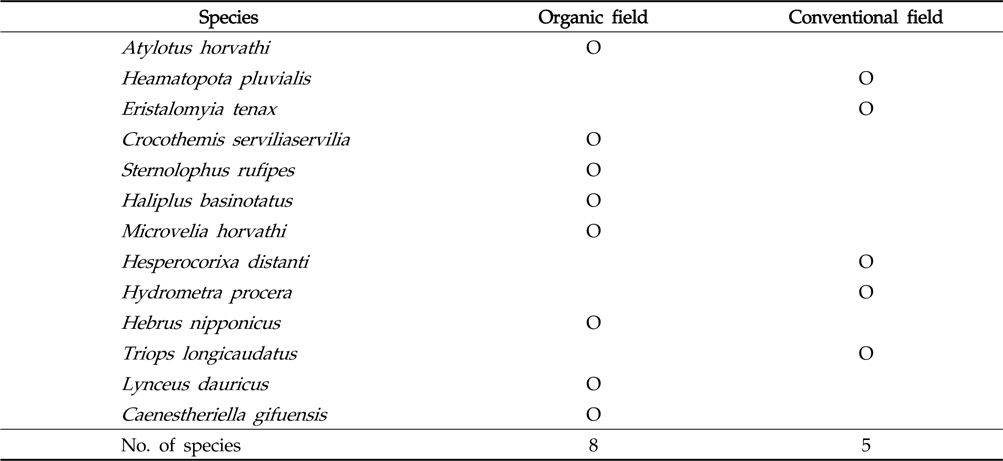
Comparison of collected benthic invertebrates in conventional and organic field at sampling sites
분류군별 구성을 살펴보면 유기농법 지역에서는 딱정벌레목(Coeoptera)이 24종으로 가장 많은 비중을 차지했으며 (30%), 그 다음으로 잠자리목(Odonata) 14종(17%), 파리목(Diptera) 13종(16%), 노린재목(Hemiptera) 13종(16%), 기안목(Basommatophora) 5종(6%) 순이었다. 관행농법 지역에서는 딱정벌레목 22종(26%), 파리목 14종(17%), 노린재목13종(15%), 잠자리목 12종(14%), 기안목 5종(6%), 중복족목(Maesogastropoda) 5종(6%) 순으로 나타났다(Fig. 3). 유기농법 지역과 관행농법 지역 모두 다른 저서생물을 포식하는 포식성 섭식기능군(Predator)의 비중이 컸고, 저수지 등과 같이 정수역에서 많이 보이는 저서생물 구성과 동일한 특성을 가지는 것을 확인 할 수 있었다(Yoon
출현 개체군을 기준으로 살펴보면 상위 다섯 번째 종까지는 유기농법과 관행농법으로 재배한 논 모두 깔다구류(Chironomidae), 패형류(Ostracoda), 새각류(Branchiopoda), 요각류(Copepoda), 아가미실지렁이(Branchiura sowerbyi Beddard) 순으로 같았고, 상위 여섯 번째 종부터 약간의 차이가 있었다. 유기농법으로 재배한 논은 왕우렁이(Anpullarius insularus), 수정또아리물달팽이(
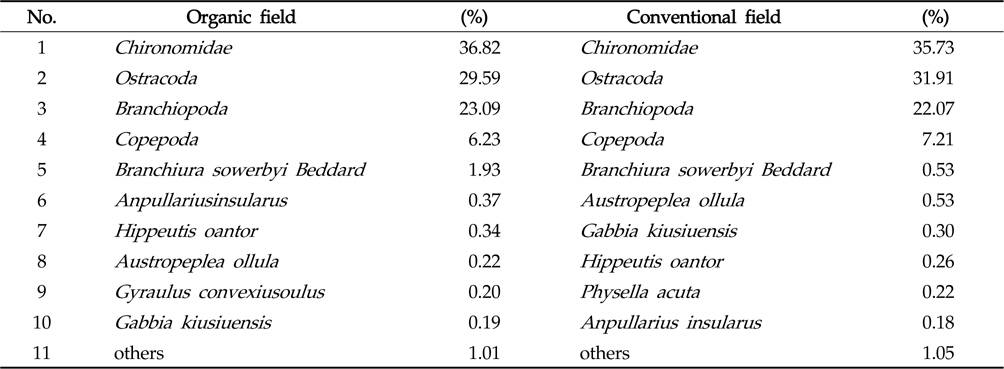
Dominant benthic invertebrate species ranking in abundance in organic and conventional field
일반적으로 논에 서식하는 저서무척추동물은 논의 특성상 깔다구류(Chironomidae)와 같은 오염의 내성 범위가 큰 종들이 분포하는 특성을 가진다(Han
유기농법 재배 논과 관행농법 재배 논의 개체수와 종수의 관계를 살펴보면, 관행농법으로 재배한 논보다 유기농법으로 재배한 논이 종수와 개체수에 있어서 넓은 범위를 가지는 것을 확인 할 수 있었다. 특히, 관행논법으로 재배한 논은 유기농법으로 재배한 논과 비슷한 종수의 범위를 갖는다고 할지라도(10종에서 30종 범위), 개체수는 유기농법 논과 비교하여 훨씬 좁은 5,000개체 미만에 대부분이 모여 있는 것을 확인 할수 있었다(Fig. 4). 이를 통해 논에 농약과 같은 화학물질이 투입될 경우 저서무척추동물의 수용능력(carrying capacity)이 급격히 떨어지는 것을 알 수 있었다. 논 생태계에서 화학 비료의 사용은 서식생물의 종수와 개체수를 급격히 감소시킨다는 결과와 동일한 결론을 본 연구에서도 얻을 수 있었다(Grant
지역별 유기농법 재배 논과 관행논법 재배 논의 종수를 살펴보면 안성(AN), 함양(HY), 김제(KI), 수원(SU)에서 차이를 확인할 수 있었고, 개체수의 차이는 안성, 군산(GU), 함양, 김제, 수원에서 확인 할 수 있었다(Table 3). 지역별 영농방법에 따른 종수와 개체수는 큰 차이를 나타냈다. 유기농법으로 재배한 지역끼리 종수와 개체수를 비교해보면 상당히 유의한 차이(p <0.001)를 나타낸 반면, 관행농법으로 재배한 지역끼리는 차이를 나타내긴 하지만 유기농법으로 재배한 지역끼리의 차이보다는 상대적으로 낮은 종수(p <0.01)와 개체수(p <0.05)의 차이를 확인 할 수 있었다. 이를 통해 관행농법 지역에 비해 유기농법 지역은 저서무척추동물이 지역에 따라 훨씬 더 큰 영향을 받는다는 것을 파악할 수 있었고 관행농법 지역의 저서무척추동물 군집 구성이 유기농업 지역보다 상대적으로 단조로운 형태를 가지는 것을 확인 할 수 있었다.
지역 내에서 종수와 개체수 모두 유의한 차이를 나타내는 지역은 안성, 함양, 김제, 수원 지역으로 확인되었다(Table 3). 그 중 수원은 생물다양성 연구를 위해 관리된 곳으로 이 지역을 제외한 나머지 지역은 조사지 주변 경관이 농업 환경뿐만 아니라 산림생태계가 잘 발달한 지역이었다(Fig. 5). 저서 생물이 수질과 같은 미시적 요인뿐만 아니라 경관과 같은 거시적 요인(large scale factors)에 의해서도 영향을 받는다는 연구결과는 이미 확인된 바 있다(Ballinger
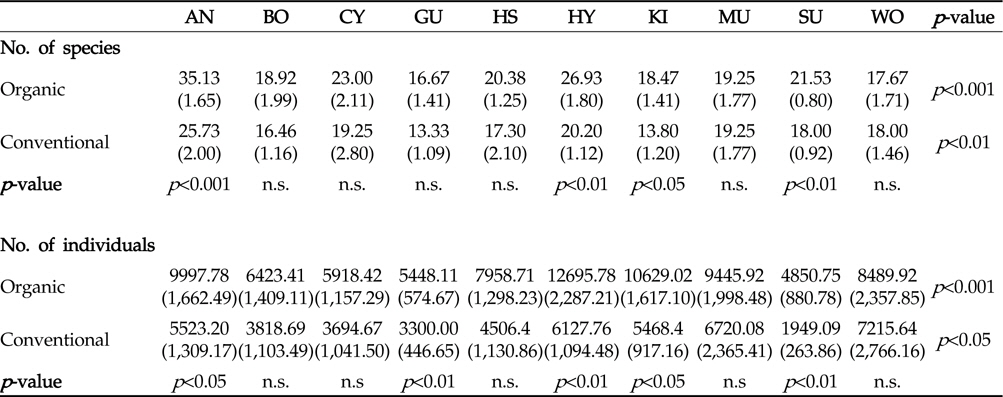
Comparison of number of individuals of benthic invertebrate at each sampling sites in organic and conventional field. Parenthesis indicate standard error. Abbreviation of the surveyed sites are shown in Figure 1
생물의 특성을 통해 그 지역의 환경을 평가하는 방법은 지속적으로 발전되어 왔으며, 본 연구에서도 유기농법 지역과 관행농법 지역에서 생물군집이 다른 구성을 갖고 있음을 저서무척추동물 군집을 통해 확인 할 수 있었다(Metcalfe, 1989). 이를 통해 농약과 같은 화학물질이 생물상에 크게 영향을 끼치고 있음을 확인하였으며, 거시적인 관점에서 이러한 영향은 산림 생태계가 발달한 논에서 크게 나타나는 것을 알수 있었다. 벼(
